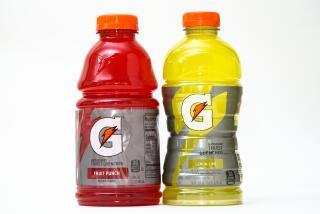Fresh Produce
- Share via
Consumers may soon find more fresh produce “shrink-wrapped” in air-tight plastic, a packaging technique that not only slows dehydration but provides a surface for slapping brand names on produce for such major marketers as Del Monte, Green Giant, Chiquita, Dole and Kraft, reports Supermarket Business.
Shrink wrapping also makes it possible for markets to add a computer-readable bar code with price and inventory data. And it can enable stores to meet consumers’ desire for fully ripened fruits and vegetables, including tomatoes and avocados--and it could expand imported produce during the domestic off-season for such perishable items as asparagus, which now must be air-shipped. Scrubbed, pricked and shrink-wrapped potatoes can be marketed as “microwave ready.”
A major strawberry producer, Driscoll Strawberry Associates of Watsonville, Calif., has concocted a giant vacuum cleaner, the “BugVac,” which it claims can clean lygus bugs, a major pest, off four rows of berries at a time, virtually eliminating the need for chemical treatments.
BugVac consists of a series of tractor-mounted, hydraulically driven fans that move just above the plants in quest of the pest while leaving the naturally occurring, beneficial insect and mite community within the field relatively undisturbed, Driscoll said.
Shoppers may not realize it, but designers give a lot of thought to store layouts to guide customers from department to department to encourage purchase of the most profitable items.
“They view the individual store as something akin to an ecosystem, one with a myriad of subtle and often subconscious yet readily manageable balances,” says Tom Pirko of Bevmark, a Los Angeles-based food and beverage consulting firm. “Shopper thoughts, feelings and ultimately buying behavior can be materially affected by altering these balances.
“For example, stores take advantage of the consumer’s tendency to favor the right side and the right hand,” Pirko said. “Hotly marketed items are positioned to provide an early ‘reward’ and easy purchase on entering.”
Shoppers generally arrive armed with lists of staple items that they intend to buy--goods the stores carefully distribute to draw customers past more profitable items of a more discretionary nature, adds Paul Gillette, Pirko’s partner and a publisher of beverage newsletters. That’s why the loss leaders featured in ads are so rarely displayed with any prominence.
“The market’s psychologists want you to search for the item,” Gillette said. “The more ground you cover in your search, the greater the likelihood that you’ll be tempted to make an impulsive purchase of something you had not intended to buy.”
More to Read
Eat your way across L.A.
Get our weekly Tasting Notes newsletter for reviews, news and more.
You may occasionally receive promotional content from the Los Angeles Times.










